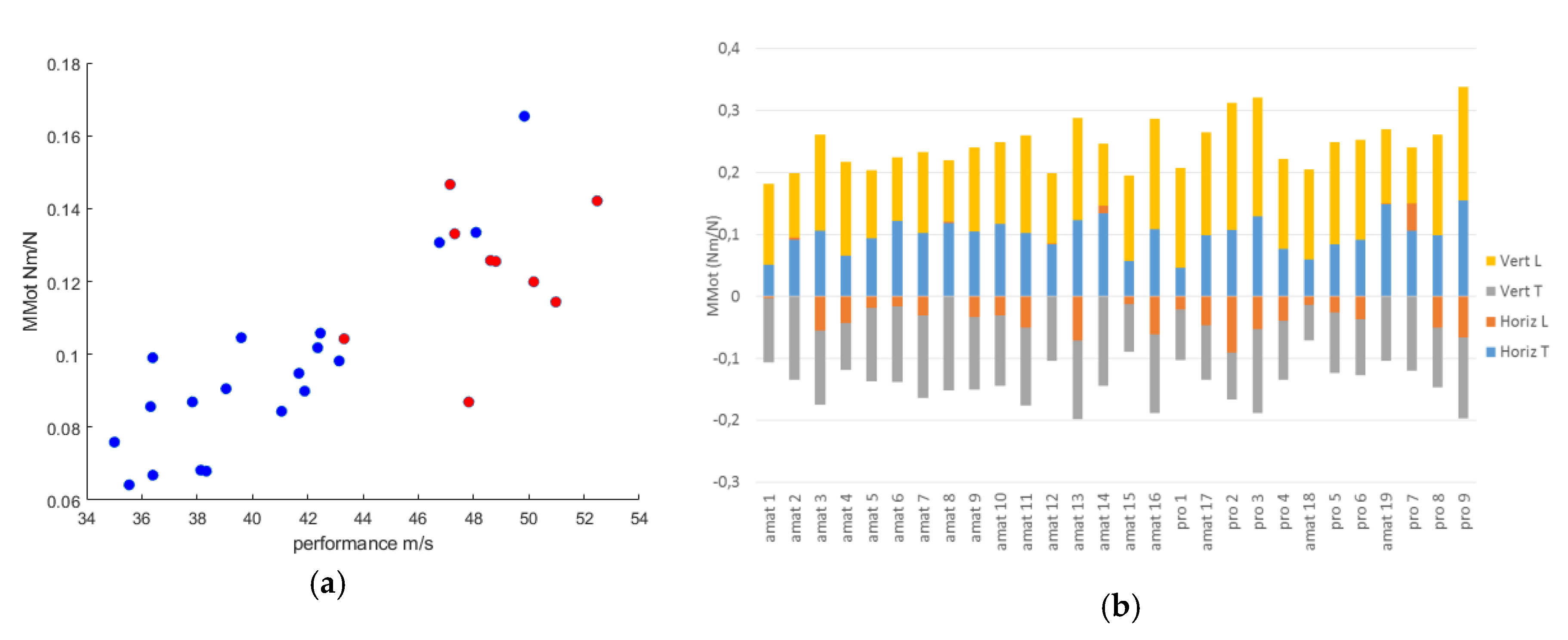Effect of Horizontal Ground Reaction Forces during the Golf Swing: Implications for the Development of Technical Solutions of Golf Swing Analysis †
Abstract
1. Introduction
2. Materials and Methods
3. Results
4. Discussion
5. Conclusions
Acknowledgments
Conflicts of Interest
References
- Cheetham, P.J.; Martin, P.E.; Mottram, R.E.; St. Laurent, B.F. The importance of stretching the “X-Factor” in the downswing of golf: The “X-Factor Stretch”. In Proceedings of the International Conference on Sport Science, Sport Medicine and Physical Education, Brisbane, Australia, 7–13 September 2000. [Google Scholar]
- Tinmark, F.; Hellström, J.; Halvorsen, K.; Thorstensson, A. Elite golfers’ kinematic sequence in full-swing and partial swing shots. Sports Biomech. 2010, 9, 236–244. [Google Scholar] [CrossRef] [PubMed]
- Marsan, T.; Thoreux, P.; Bourgain, M.; Rouillon, O.; Rouch, P.; Sauret, C. Biomechanical analysis of the golf swing: Methodological effect of angular velocity component on the identification of the kinematic sequence. Acta Bioeng. Biomech. 2019, 21. [Google Scholar] [CrossRef]
- Kwon, Y.-H.; Han, K.H.; Como, C.; Lee, S.; Singhal, K. Validity of the X-factor computation methods and relationship between the X-factor parameters and clubhead velocity in skilled golfers. Sports Biomech. 2013, 12, 231–246. [Google Scholar] [CrossRef] [PubMed]
- Chu, Y.; Sell, T.C.; Lephart, S.M. The relationship between biomechanical variables and driving performance during the golf swing. J. Sports Sci. 2010, 28, 1251–1259. [Google Scholar] [CrossRef] [PubMed]
- Stastny, P.; Maszczyk, A.; Tomankova, K.; Kubovy, P.; Richtrova, M.; Otahal, J.; Cichoň, R.; Mostowik, A.; Zmijewski, P.; Cięszczyk, P. Kinetic and Kinematic Differences in a Golf Swing in One and Both Lower Limb Amputees. J. Hum. Kinet. 2015, 48, 33–41. [Google Scholar] [CrossRef] [PubMed]
- Wang, J.-J.; Yang, P.-F.; Ho, W.-H.; Shiang, T.-Y. Determine an effective golf swing by swing speed and impact precision tests. J. Sport Health Sci. 2015, 4, 244–249. [Google Scholar] [CrossRef][Green Version]
- McNitt-Gray, J.L.; Munaretto, J.; Zaferiou, A.; Requejo, P.S.; Flashner, H. Regulation of reaction forces during the golf swing. Sports Biomech. 2013, 12, 121–131. [Google Scholar] [CrossRef]
- Bourgain, M.; Hybois, S.; Thoreux, P.; Rouillon, O.; Rouch, P.; Sauret, C. Effect of shoulder model complexity in upper-body kinematics analysis of the golf swing. J. Biomech. 2018, 75, 154–158. [Google Scholar] [CrossRef]
- Delp, S.L.; Anderson, F.C.; Arnold, A.S.; Loan, P.; Habib, A.; John, C.T.; Guendelman, E.; Thelen, D.G. OpenSim open-source software to create and analyze dynamic simulations of movement. IEEE Trans. Bio-Med. Eng. 2007, 54, 1940–1950. [Google Scholar] [CrossRef] [PubMed]
- Morrison, A.; McGrath, D.; Wallace, E.S. The relationship between the golf swing plane and ball impact characteristics using trajectory ellipse fitting. J. Sports Sci. 2017, 1–8. [Google Scholar] [CrossRef] [PubMed]
- Kwon, Y.-H.; Como, C.S.; Singhal, K.; Lee, S.; Han, K.H. Assessment of planarity of the golf swing based on the functional swing plane of the clubhead and motion planes of the body points. Sports Biomech. 2012, 11, 127–148. [Google Scholar] [CrossRef] [PubMed]
- Bourgain, M.; Sauret, C.; Rouillon, O.; Thoreux, P.; Rouch, P. Contribution of vertical and horizontal components of ground reaction forces on global motor moment during a golf swing: A preliminary study. Comput. Methods Biomech. Biomed. Eng. 2017, 20, 29–30. [Google Scholar] [CrossRef] [PubMed]
- Egret, C.; Dujardin, F.; Weber, J.; Chollet, D. 3-D kinematic analysis of the golf swings of expert and experienced golfers. J. Hum. Mov. Stud. 2004, 47, 193–204. [Google Scholar]
- Meister, D.W.; Ladd, A.L.; Butler, E.E.; Zhao, B.; Rogers, A.P.; Ray, C.J.; Rose, J. Rotational biomechanics of the elite golf swing: Benchmarks for amateurs. J. Appl. Biomech. 2011, 27, 242–251. [Google Scholar] [CrossRef] [PubMed]



| GPro | GA | Overall | |
|---|---|---|---|
| Club head velocity (m/s) Mean (standard deviation) | 48.5 (2.6) | 40.5 (4.3) | 43.1 (5.3) |
| Downswing duration (s) | 0.26 (0.02) | 0.28 (0.02) | 0.27 (0.04) |
| Maximum VGRF (N/N) Mean (SD) lead/trail | 1.181(0.285) 0.642(0.070) | 1.241(0.206) 0.696(0.136) | 1.222(0.230) 0.679(0.120) |
| Maximum HGRF(N/N) Mean (SD) lead/trail | 0.158(0.06) 0.131(0.04) | 0.186(0.08) 0.127(0.07) | 0.177(0.07) 0.128(0.06) |
Publisher’s Note: MDPI stays neutral with regard to jurisdictional claims in published maps and institutional affiliations. |
© 2020 by the authors. Licensee MDPI, Basel, Switzerland. This article is an open access article distributed under the terms and conditions of the Creative Commons Attribution (CC BY) license (https://creativecommons.org/licenses/by/4.0/).
Share and Cite
Bourgain, M.; Sauret, C.; Prum, G.; Valdes-Tamayo, L.; Rouillon, O.; Thoreux, P.; Rouch, P. Effect of Horizontal Ground Reaction Forces during the Golf Swing: Implications for the Development of Technical Solutions of Golf Swing Analysis. Proceedings 2020, 49, 45. https://doi.org/10.3390/proceedings2020049045
Bourgain M, Sauret C, Prum G, Valdes-Tamayo L, Rouillon O, Thoreux P, Rouch P. Effect of Horizontal Ground Reaction Forces during the Golf Swing: Implications for the Development of Technical Solutions of Golf Swing Analysis. Proceedings. 2020; 49(1):45. https://doi.org/10.3390/proceedings2020049045
Chicago/Turabian StyleBourgain, Maxime, Christophe Sauret, Grégoire Prum, Laura Valdes-Tamayo, Olivier Rouillon, Patricia Thoreux, and Philippe Rouch. 2020. "Effect of Horizontal Ground Reaction Forces during the Golf Swing: Implications for the Development of Technical Solutions of Golf Swing Analysis" Proceedings 49, no. 1: 45. https://doi.org/10.3390/proceedings2020049045
APA StyleBourgain, M., Sauret, C., Prum, G., Valdes-Tamayo, L., Rouillon, O., Thoreux, P., & Rouch, P. (2020). Effect of Horizontal Ground Reaction Forces during the Golf Swing: Implications for the Development of Technical Solutions of Golf Swing Analysis. Proceedings, 49(1), 45. https://doi.org/10.3390/proceedings2020049045





